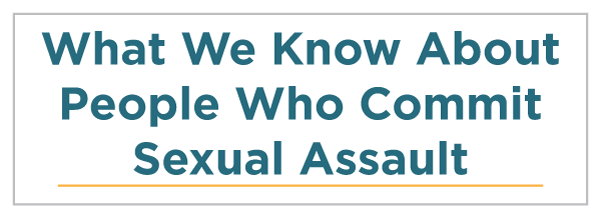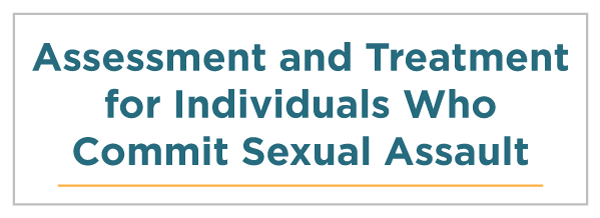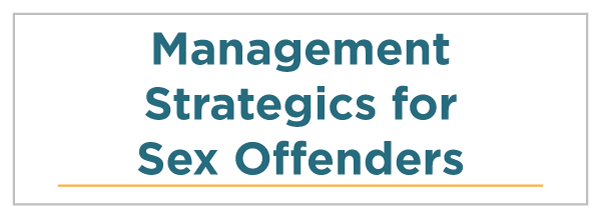
 |
 |
 |
 |
The majority of individuals who commit sexual assault will return to their families and the communities where they committed the offense. [53] Depending on the location, that could include circumstances where the victim and offender are living in the same home, on the same street, or in the same town.
Developing management and treatment programs for successful reintegration keeps communities and individuals safer by reducing the risk of future assaults through engaging, rather than ignoring or dehumanizing, the offender or victim.
Management approaches must be tailored to the circumstances of each individual who commits a sexual offense. The Comprehensive Approach to Sex Offender Management developed by the Center for Sex Offender Management provides fundamental principles and key components to integrate the different management options for those who sexually assault. The RNR model reinforces the notion that management programs should be geared toward the unique risk factors, protective factors, and needs of each individual, as well as the treatment model most likely to be effective. Risk should be continuously assessed and interventions adjusted based on the static and dynamic risk of the individual.
Specialized supervision for adult sex offenders can also be effective when paired with sex-offense-specific treatment. Specialized supervision frequently involves probation and parole officers specifically trained in strategies for sex offenders, which may include integration of the family and other community members who are informed about the individual.
The risks and needs of adolescents tend to be different from adults, taking into account developmental factors. Access to and engagement with peers, school, and the community are important, along with strategies that provide structure, support, and supervision. [54]
Sex Offender Registration and Notification (SORN), or maintaining public records of individuals who commit sexual offenses, is one strategy implemented by federal, state, territories, and tribal governments with the purpose of increasing community safety.
The federal government first implemented a national registration law in 1994, with repeated changes since then. Changes include enhanced registration requirements and increased availability of information to the public. [55] The Sentencing, Monitoring, Apprehending, Registering and Tracking (SMART) office provides a history of federal sex offender registration legislation.
Research to date is very limited on the effectiveness of registration and notification on stopping those who have sexually assaulted from choosing to commit another sexual offense, and researchers are continuing to explore this important question. Research on law enforcement perceptions of SORN, and especially the registration component, does provide support for its use as a criminal investigation tool.
Research about public perceptions has found the public to be generally supportive of having access to registry information. [56] Requiring adolescents to register is controversial, especially given the lack of research demonstrating its efficacy in reducing recidivism among adolescents. [57]
Recent SORN guidelines have been amended to allow states to exclude the application of SORN to adolescents except for those who commit the most serious sexual assaults.
Juvenile Offender Resources
This chapter of the SOMAPI report discusses findings from studies about juveniles who sexually offend.
SMART Summary: Prosecution, Transfer, and Registration of Serious Juvenile Sex Offenders (PDF, 31 pages)
This report covers the topics of juvenile courts, juveniles tried as adults, public registry postings, and more.
SMART Watch Dispatch: Juvenile Sex Offender Registration and SORNA (PDF, 2 pages)
This brief document discusses SORNA standards, juvenile registration, and guidance for jurisdictions.
Residence restrictions, which are not required by federal SORN laws, are typically established to prevent those who commit sexual assaults from living within 1,000 to 2,500 feet of schools, daycare centers, and other places where children congregate. Currently, 30 states and many more municipalities, and some tribal jurisdictions, have residence restrictions. [58]
There was no research evidence to support the effectiveness of residence restrictions in preventing sex offender recidivism prior to implementation. Research completed since the passage of these laws shows that residence restrictions are not effective in reducing recidivism. [59] While such policies may be popular, they tend to push offenders into riskier situations and may increase risk to the community by interfering with protective factors like housing and employment. [60] Residence restrictions are not recommended as sex offender management policy.
For more information about the research on residence restrictions, see Chapter 8 of the SOMAPI report.
The number of people who have committed a sexual crime and are under correctional supervision in the community has increased substantially over the past 20 years. [61] As a result, increasing emphasis has been placed on identifying re-entry strategies for sex offenders. In a federally funded initiative, the Council of State Governments has developed a National Sex Offender Reentry Initiative.
Three re-entry strategies of interest are reviewed below:
For more information and resources on community reentry strategies, see the SOMAPI report, Chapter 8: Sex Offender Management Strategies, and the SMART Office grant-funded initiatives.
Sex Offender Civil Commitment (SOCC) is designed for offenders deemed to be at continued high risk to re-offend if they are not preventively detained and offered treatment designed to lower their risk for recidivism. At present, 20 states, the District of Columbia, and the federal government have legislation allowing for SOCC procedures to keep an individual in confinement, even after their sentence is completed.
To be subject to civil commitment, most SOCC statutes require the state to demonstrate that a potential candidate has — [63]
A sex offender subject to a civil commitment can be held until a court finds they no longer meet the criteria for commitment. [64]
There is little research on the effectiveness of this policy, as very few civil commitment detainees have been released. Given the expense and lack of research, the best practice is for jurisdictions to exercise caution when choosing to implement this policy.
For more information, see the SOMAPI report, Chapter 8: Sex Offender Management Strategies, and the Civil Commitment Educational Briefs.
The use of global positioning systems (GPS) and polygraph testing may be used with other management policies such as supervision. GPS monitors and verifies the location of the device worn by a sex offender. Research on the use of GPS has found that equipment problems, signal drift, blocked signals, and high caseloads impact its effectiveness. [65]
A polygraph may be useful in verifying truthfulness related to sexual history, and treatment and supervision compliance. [66] While used extensively with adults in some states, there is a lack of conclusive research on the use of the polygraph with adolescents, and therefore its use remains controversial.
Both tools lack sufficient research to recommend them as a standalone strategy, but they may be useful in conjunction with an overall supervision strategy, depending on the risk and need of an individual. However, the use of polygraph examination for adolescents is not recommended by ATSA. [67] For more information on these strategies, see the SOMAPI report, Chapter 8: Sex Offender Management Strategies.
Arizona Standards and Guidelines for the Effective Management of Adult Sex Offenders on Probation (PDF, 77 pages)
This document describes standards and guidelines related to pre-sentence investigations, treatment providers, offenders on probation, polygraphs, and other issues.
Association for the Treatment of Sexual Abusers Professional Code of Ethics (PDF, 41 pages)
This code of ethics includes ethical principles, rules, and procedures.
ATSA Infographics: People Are Talking About Preventing Sexual Abuse
These ready-to-distribute infographics and information from ATSA show people how to approach the conversation of preventing sexual abuse.
This document by the National Alliance to End Sexual Violence serves as a policy statement on the management of sex offenders.
Community Supervision of the Sex Offender: An Overview of Current and Promising Practices
This resource by the Center for Sex Offender Management (CSOM) discusses practices and lessons learned in communities throughout the country.
This CSOM resource assists jurisdictions with understanding and assessing sex offender policies and practices.
Effective Management of Sex Offenders Residing in Open Communities (PDF, 6 pages)
This resource by the California Coalition on Sexual Offending includes components of sex offender containment approaches, collaborative partnerships, treatment standards, surveillance, and public policy perspectives.
Enhancing the Management of Adult and Juvenile Sex Offenders — A Handbook for Policymakers and Practitioners (PDF, 102 pages)
This handbook by CSOM reviews sex offender management, the framework and steps for multidisciplinary responses, and recommendations for collecting and monitoring data.
The Impact of Residency Restrictions on Sex Offenders and Correctional Management Practices: A Literature Review (PDF, 57 pages)
This resource by the California Research Bureau reviews the impact of offender residency restrictions on criminal justice management practices and sex offender treatment programs.
Info and Stats for Journalists: People Who Commit Sexual Violence (PDF, 2 pages)
This fact sheet by the National Sexual Violence Resource Center provides guidance for journalists who are reporting about people who commit sexual violence, including statistics about offending.
Key Findings: Rethinking Serial Perpetration (PDF, 16 pages)
This research translation discusses findings that suggest most perpetrators do not chronically offend over time.
Managing Sex Offenders in the Community: A Handbook to Guide Policymakers and Practitioners through a Planning and Implementation Process (PDF, 102 pages)
This guide by CSOM helps policymakers and practitioners assess and strengthen their approaches to managing adult and juvenile sex offenders.
MASOC is a coalition of professionals committed to stopping sexual abuse through early and specialized intervention, assessment, treatment, and management in the lives of sexually abusive children and youth. Resources include a directory of providers, policy papers on rethinking our approach to adolescents, information about including adolescents on the sex offender registry, and a new Massachusetts Child/Adolescent Assessment Protocol for evaluation of adolescents and older children.
The National Center on Sexual Behavior of Youth (NCSBY)
NCSBY’s website covers guidelines, research, and clinical articles on adolescents and children who have committed a sexual crime. Information is available for parents and caregivers and professionals working with youth.
Promoting Collaboration Between Victim Advocates and Sex Offender Management Professionals: A Resource Package (PDF, 49 pages)
This project funded by the Office on Violence Against Women (OVW) provides resources about collaboration between victim advocates and sexual offender treatment providers.
This report from CSOM addresses the importance of the public as a partner in the criminal justice system’s response to sex offenders.
Resource Package for Paroling Authorities on Sex Offenders
National Parole Resource Center provides this resource packet to assist paroling authorities with sex offender management practices.
Standards and Guidelines for the Assessment, Evaluation, Treatment and Behavioral Monitoring of Adult Sex Offenders (PDF, 226 pages)
This resource from the Colorado Sex Offender Management Board establishes a basis for systematic management and treatment of adult sex offenders.
Standards and Guidelines for the Evaluation, Assessment, Treatment, and Supervision of Juveniles who Have Committed Sexual Offenses (PDF, 156 pages)
This resource from the Colorado Sex Offender Management Board provides information on victims, standards of practice for treatment providers, qualifications of providers, multidisciplinary teams, conditions of community supervision, and polygraph examinations.
Stop SV: A Technical Package to Prevent Sexual Violence (PDF, 48 pages)
This technical package discusses prevention strategies, including approaches specific to preventing perpetration.
Time to Work: Managing the Employment of Sex Offenders Under Community Supervision (PDF, 12 pages)
This report by CSOM discusses sex offender employment, including assessing potential job placements, approaches to job searches, making sound job placement decisions, developing relationships with employers, and monitoring sex offenders’ job-related activities.
What You Need to Know About Sex Offenders in Your Community (PDF, 20 pages)
This resource by the National Center for Missing & Exploited Children provides answers to commonly asked questions about sex offenders living in local communities.
Circles of Support and Accountability (CoSA)
CoSA Canada is the Canadian national organization for Circles of Support and Accountability. This Canadian-made restorative justice program is designed for adult men and women who have committed serious sexual offences. CoSA allows the community to play a direct role in the restoration, reintegration, and risk management of people who have sexually offended.
A Collaborative Approach for Family Reconciliation and Reunification with Youth who Have Caused Sexual Harm (PDF, 26 pages)
This resource by Joann Schladale explains the difference between reconciliation and reunification, provides information on barriers to successful reunification, and gives recommendations for treatment.
Considering Family Reconnection and Reunification after Child Sexual Abuse: A Road Map for Advocates and Service Providers (PDF, 72 pages)
This guide by the National Sexual Violence Resource Center helps advocates work with families considering reunification with a family member who has sexually offended.
Key Considerations for Reunifying Adult Sex Offenders and their Families (PDF, 13 pages)
This resource by CSOM was designed for parole and probation officers, advocates, and treatment providers who work with people who have sexually offended. The guide includes issues to consider and assessments to determine readiness for reunification.
National Reentry Resource Center
The National Reentry Resource Center assists professionals working with criminal offenders, including those who have committed sexual offenses, in returning to the community.
An Overview of Sex Offender Reentry: Building a Foundation for Professionals
This webinar by the National Reentry Resource Center provides a foundational overview of sex offender re-entry, with a focus on criminal justice professionals.
Managing Sex Offenders: Citizens Supporting Law Enforcement (PDF, 52 pages)
This document by the International Association of Chiefs of Police explores legislation related to tracking and monitoring sex offenders, identifies the challenges faced by law enforcement, and examines the role that citizens play in assisting law enforcement in these efforts.
The National Public Sex Offender Website (NSOPW)
The NSOPW website has a list of registered sex offenders throughout the United States as well as a number of resources related to prevention of and intervention to address sexual assault. It also provides links to most state sex offender registries and websites.
New York State Sex Offender Registry and the Sex Offender Registration Act
This page from the New York State Sex Offender Registry describes sex offender risk levels, which govern the amount and type of community notification authorized for sex offenders.
The Estimate of Risk of Adolescent Sexual Offense Recidivism (ERASOR) (PDF, 51 pages)
The ERASOR is a structured professional judgment tool to assist evaluators in estimating the short-term risk of a sexual re-offense for youth aged 12-18.
The Importance of Assessment in Sex Offender Management: An Overview of Key Principles and Practices (PDF, 12 pages)
This overview by the CSOM discusses the role assessments play in ensuring informed and effective management of sex offenders.
Juvenile Sex Offender Assessment Protocol-II (J-SOAP-II) (PDF, 32 pages)
The J-SOAP-II is a checklist whose purpose is to aid in the systematic review of risk factors that have been identified in the professional literature as being associated with sexual and criminal offending. It is designed to be used with boys in the age range of 12 to 18 who have been adjudicated for sexual offenses, as well as non-adjudicated youths with a history of sexually coercive behavior.
MnSOST-R (PDF, 43 pages)
Since the 1990s, the MnSOST-R has been one of the most widely used sex offender risk assessment tools for adults. Recently, the MnSOST-R was updated through the development of the MnSOST-3.
Risk Matrix 2000 (PDF, 44 pages)
Risk Matrix 2000 is a statistically derived risk-classification process intended for adult males aged at least 18 who have been convicted of a sex offense.
Sex Offender Management and Assessment Planning Initiative
The SMART Office has published information on research and best practices related to sex offender management and treatment of adults and juveniles who commit sexual offenses. Chapter 6 covers risk assessment of adults who commit sexual offenses, and Chapter 4 covers assessment of juveniles who commit sexual offenses.
Sex Offender Treatment Intervention and Progress Scale (SOTIPS) (PDF, 51 pages)
SOTIPS is a 16-item, statistically derived dynamic measure designed to aid clinicians, correctional caseworkers, and probation and parole officers in assessing risk, treatment and supervision needs, and progress among adult male sex offenders.
Sexual Violence Risk — 20 (SVR-20) (PDF, 9 pages)
The SVR-20 is a 20-item checklist of risk factors for sexual assault that were identified by a review of the literature on sex offenders.
The STABLE-2007 and the ACUTE-2007 are specialized tools designed to assess and track changes in risk status over time by assessing changeable dynamic risk factors used primarily with the adult population.
Static-99 is a 10-item actuarial assessment instrument for use with adult male sexual offenders who are at least 18 years of age at time of release to the community. In 2012, the age item for the scale was updated, creating Static-99R. Static-99R is the most widely used sex offender risk assessment in the world.
Vermont Assessment of Sex Offender Risk-2 (VASOR-2) (PDF, 41 pages)
VASOR-2 is designed to assess risk among adult males who have been convicted of at least one qualifying sex offense. It is comprised of a 12-item Reoffense Risk Scale and a 4-item Severity Factors Checklist.
Violence Appraisal Risk Guide and Sex Offender Risk Appraisal Guide (PDF, 14 pages)
These actuarial scales predict further violence of men or women who have committed criminal assault or recidivism of men who have committed at least one hands-on sexual offense.
Association for the Treatment of Sexual Abusers (ATSA)
ATSA promotes evidence-based practice, public policy, and community strategies to help assess, treat, and manage sexual abusers. Its website provides public policy information, publications on standards of treatment, and a code of ethics.
The Center for Sex Offender Management (CSOM)
CSOM acts as an information exchange and provides training and technical assistance to those who work in sex offender management.
National Adolescent Perpetration Network (NAPN)
NAPN is the leading national membership organization for professionals who serve children and adolescents who have perpetrated sexual abuse. Founded in 1983, NAPN remains dedicated to the promotion and rapid dissemination of developmentally informed evidence-based best practices in assessment, treatment, and case management.
National Alliance to End Sexual Violence (NAESV)
NAESV works for state coalitions and local programs to end sexual violence and support survivors. Part of their work is based upon the belief that policies formulated to manage sex offenders must have as a primary goal the prevention of future sexual victimization. Such policies must hold sex offenders accountable while providing support and safety for victims and their families.
The National Center for Missing and Exploited Children
This site provides resources related to sexual assaults and those who perpetrate or are victimized by such behavior, and prevention-oriented resources.
National Sex Offender Public Website
The National Sex Offender Public Website is an unprecedented public safety resource that provides the public with access to information about sex offenders nationwide. The website also offers information about national resources as well as prevention and education information.
NEARI Press is a source of practical, cutting-edge information for professionals and the public about promising and best-practice interventions with adult and adolescent sex offenders or with those who display sexual behavior problems. In addition to books, NEARI Press offers webinars, a monthly newsletter, and free online courses.
Office of Sex Offender Sentencing, Monitoring, Apprehending, Registering, and Tracking (SMART Office)
The SMART Office website offers states guidance regarding the implementation of the Adam Walsh Act, provides technical assistance, tracks legislative and legal developments related to sex offenders, and administers grant programs.
This foundation supports the Safer Society Press, which publishes books on all aspects of sex offending. In addition to books, SSFI offers free materials to the families of incarcerated offenders.
Sex Offender Management and Assessment Planning Initiative
The SMART Office has published information on research and best practices related to sex offender management and treatment of adults and juveniles who commit sexual offenses. Full detailed chapters and short research briefs are available on incidence and prevalence of sexual abuse, internet-facilitated sexual offending, recidivism, and more.
Stop It Now! makes helping adults take responsibility to prevent and stop child sexual abuse a main focus of prevention and creates effective programs based on these principles. The organization offers services, advocacy, prevention education, and technical assistance and training.
Below is a selection of state agencies with resources in sex offender assessment, treatment, and management. Explore your state’s resources to identify programs, resources, and initiatives in your area.
California Coalition on Sexual Offending
This coalition represents professionals who work with sexual abusers (e.g., law enforcement, community services). Its website links to conference information, research, public policy, guidelines, and other resources.
California Research Bureau (CRB)
The CRB provides nonpartisan research services to the governor and his or her staff, to both houses of the legislature, and to other elected state officials.
California Sex Offender Management Board (CASOMB)
The vision of the CASOMB is to decrease sexual victimization and increase community safety by addressing issues, concerns, and problems related to community management of adults who commit sexual offenses.
Colorado Division of Criminal Justice — Office of Research and Statistics
The mission of the Office of Research and Statistics is to apply the highest level of scientific rigor and objectivity in the study of criminal justice policies, programs, and practices, and to identify activities that improve the administration of justice. This includes educating policymakers, practitioners, fellow researchers, and the public through the timely dissemination of research findings.
Colorado Sex Offender Management Board
The Colorado Sex Offender Management Board develops standards and guidelines for managing adult and juvenile sex offenders. Its website includes links to reports, research and training materials, reference guides, sample safety plans and forms, protocols, and a list of additional links.
Community Supervision of Sex Offenders (PDF, 129 pages)
This evaluation report recommends improvements in supervision and treatment of and housing for sex offenders living in Minnesota.
Illinois Sex Offender Management Board
The function of the Sex Offender Management Board is to standardize the evaluation, treatment, and management of sex offenders at each stage of the criminal, juvenile justice, or mental health systems, so that those offenders will curtail recidivistic behaviors, and the protection of victims and potential victims will be enhanced.
Massachusetts Association for the Treatment of Sexual Abusers (MATSA)
MATSA is the state chapter of the national ATSA. In addition to providing a directory of providers working with adults in Massachusetts, MATSA provides practical resources such as a directory of providers working with adults and amicus briefs on a variety of topics.
Minnesota Association for the Treatment of Sexual Abusers
Resources at the Minnesota chapter of ATSA include lists of treatment programs for adult and adolescent offenders.
The Minnesota Department of Corrections
The Minnesota Department of Corrections provides educational materials for communities and parents, including safety tips, training materials, and a collaborative process for community notification.
New York Office of Sex Offender Management
This office supports civil management of sex offenders in New York, as well as working to ensure more effective management of sex offenders across the state.
Texas Council on Sex Offender Treatment (CSOT)
Since 1983, CSOT has been recognized by the state of Texas as the experts in the treatment and management of sex offenders. CSOT sets forth the standards of practice for the sex offender treatment providers in the state.
The Vermont Center for the Prevention and Treatment of Sexual Abuse (VCPTSA)
The mission of VCPTSA is to coordinate and support statewide, collaborative efforts to prevent sexual abuse and sexual violence. This coordination includes a strategic plan for providing access to treatment for both victims and persons with sexually harmful behaviors. VCPTSA provides information for families, judicial and law enforcement, and other professionals.
San Diego County Sex Offender Management Council
This council includes a coalition of professionals in the criminal justice system that developed standards to improve the evaluation, treatment, and supervision of sex offenders and now meets regularly to discuss emerging issues. Its website links to treatment and education information and training events.
San Diego Sex Offender Treatment Standards (PDF, 79 pages)
This resource provides standards of practice for treatment providers and information on establishing interagency community supervision teams.
| Back | Index | Next |
